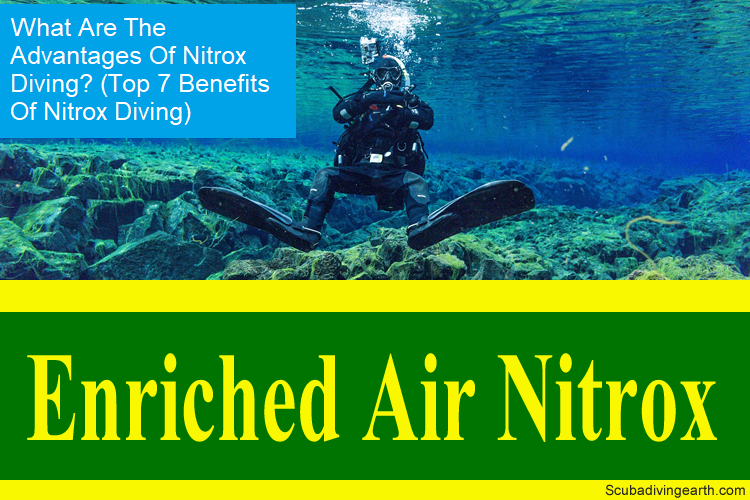
Why is Nitrox better for diving and how deep can you dive with Nitrox?
Using Enriched Air Nitrox (EAN) is not the answer for all dives so you may be wondering what are the advantages of diving with nitrox. Is nitrox worth the extra training expense and the additional cost for an air fill? Scuba diving with nitrox has its limits, which is why it’s important to understand the pros and cons of nitrox.
What is the advantage of nitrox diving?
- Extended bottom times.
- Reduced risk of decompression sickness.
- Shorter surface intervals.
- Reduced exhaustion.
- Lower risk on repetitive dives.
- Improves safety for older divers.
- Increased safety margin.
The best way to do more diving is to book yourself on a scuba diving liveaboard. You can check the latest and best deals on liveaboards using the following window:
The above advantages of nitrox diving are explained in more detail below.
What is Nitrox scuba diving and what does ‘Nitrox’ mean?
The term Nitrox refers to any gas mixture composed mostly of nitrogen and oxygen. Atmospheric air, is approximately 78% nitrogen, 21% oxygen. In other words 21% nitrox. But when the air mix between nitrogen and oxygen has a higher percentage of oxygen than 21% this is called enriched air of EAN.
The most common mixture of nitrox contains 32% oxygen or Nitrox 32. In this case the nitrogen percentage drops to 68% if you ignore the other trace gas elements. Scuba gas tanks are clearly marked with the yellow-green sticker to indicate the higher oxygen content.
In the Oxford dictionary, the word ‘Nitrox’ is defined: ‘A mixture of oxygen and nitrogen used as a breathing gas by divers, especially a mixture containing a lower proportion of nitrogen than is normally present in air, to reduce the risk of decompression sickness.’
What are the benefits of diving with Nitrox?
1. Nitrox diving extends bottom time
As recreational Nitrox contains a higher percentage of oxygen it also contains a lower percentage of nitrogen. It is the lower nitrogen content that allows divers to extend their no-decompression stop limits. This lower percentage of nitrogen means less nitrogen is absorbed by the diver’s body. The higher the Nitrox percentage, the lower the nitrogen content and the lower the nitrogen absorption an any given depth.
Examples of extended bottom times diving on Nitrox:
- Dive to 30 metres (98 feet) on Nitrox 32 (i.e. 32% oxygen) increases bottom time by 10 minutes from 20 minutes to 30 minutes. That’s a 50% bottom time increase.
- If you use a 40% mix of oxygen (i.e. Nitrox 40) on a dive to 24 metres (80 feet), your bottom time is increased from 30 minutes to 74 minutes. That’s a 247% increased bottom time.*
* Make sure you have good air consumption so you make your Nitrox air mix last this long. But also make sure you dive with a dive buddy who is also using the same Nitrox mix as well.
The added benefit of diving on nitrox is when you dive multiple dives each day. Diving on nitrox will give you extended bottom times on you repeat dives. This is particularly useful for liveaboard diving as you often dive three to four dives each day.
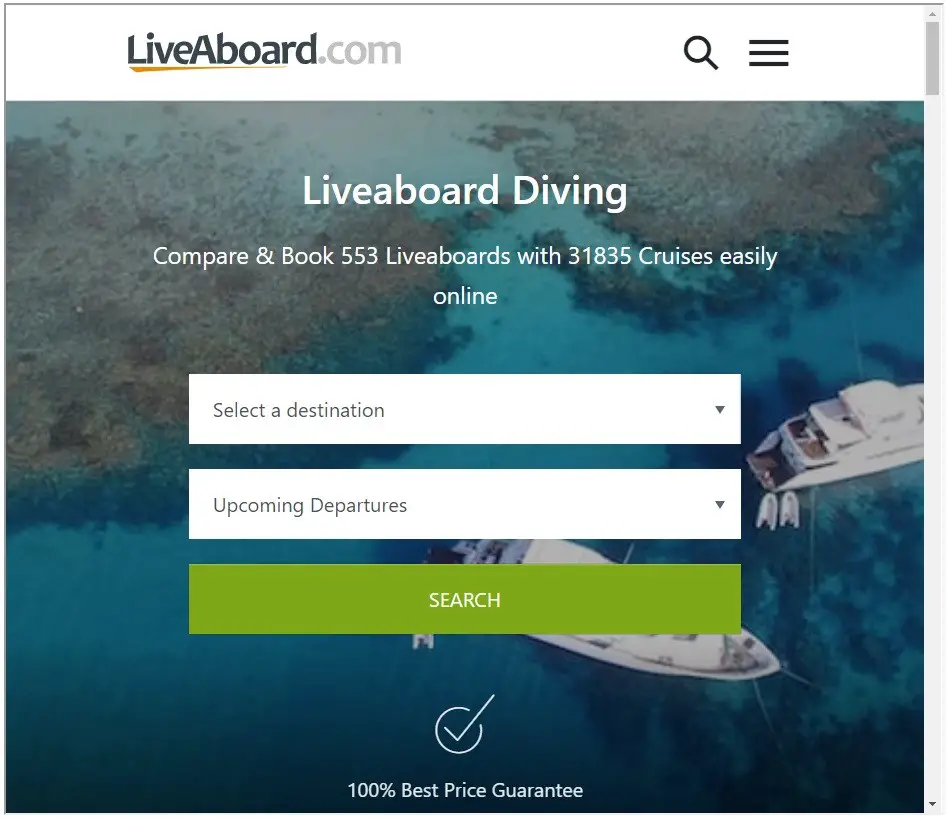
Table of dive liveaboards
This list of liveaboards is in descending customer rating order, followed by Scuba Diving Luxury Rating (SDE Lux Rating, see below), so the liveaboards with the highest customer rating and the best SDE lux rating will be at the top of the list. If you want to change the list order, use the “Sort by” dropdown below.
| Discover Liveaboard | Customer Rating | SDE Lux Rating % | Flexible Booking | Dive Courses | Dietary Requirements | Nitrox | Country | |
|---|---|---|---|---|---|---|---|---|
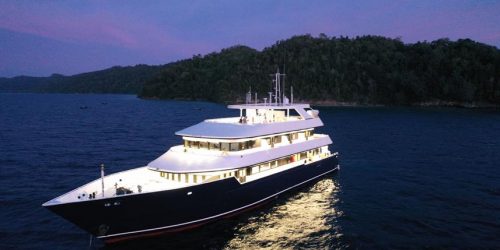 | Review: MV Seaisee; Book: MV Seaisee | 10 | 90% | YES | NO | YES | YES | Indonesia |
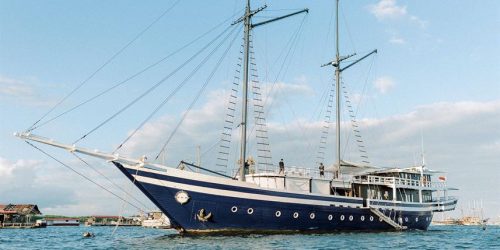 | Review: Scubaspa Zen; Book: Scubaspa Zen | 10 | 88% | YES | YES | YES | YES | Indonesia |
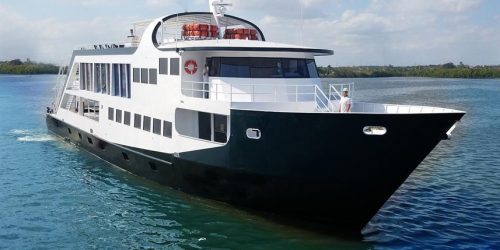 | Review: Jardines Avalon Fleet; Book: Jardines Avalon Fleet | 10 | 83% | YES | NO | YES | YES | Cuba |
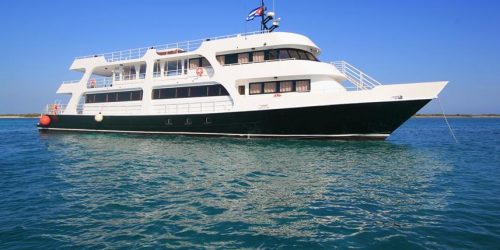 | Review: Jardines Avalon Fleet - Charter Only; Book: Jardines Avalon Fleet - Charter Only | 10 | 83% | YES | NO | YES | YES | Cuba |
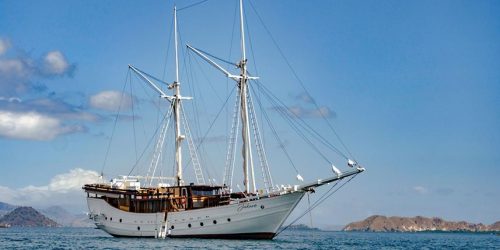 | Review: Jakaré; Book: Jakaré | 10 | 81% | YES | YES | YES | YES | Indonesia |
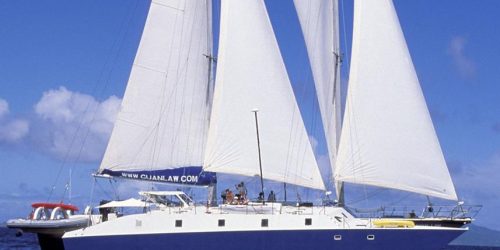 | Review: All Star Cuan Law; Book: All Star Cuan Law | 10 | 79% | YES | YES | YES | NO | Virgin Islands |
 | Review: Leyla; Book: Leyla | 10 | 73% | YES | YES | YES | NO | Indonesia |
The Scuba Diving Earth Luxury Rating (SDE Lux Rating) is explained on each liveaboard review when you click the “Discover Liveaboard” link, and is my own Liveaboard Luxury Rating I’ve assigned to all liveaboards. Choosing between liveaboards is helped by customer scores, and if you get stuck choosing between two or three liveaboards, where each one has a high customer score out of 10, you can use the SDE Luxury Rating to help narrow down your choice.
Think about it like using Booking.com when searching for the best hotel. Booking.com also use a customer score where each customer rates hotels out of 10. This is similar to the liveaboard customer rating, which is also rated out of 10. But let’s say you only like to stay in hotels rated 8 and above on Booking.com, but you also want the hotel to have WIFI or parking, or to have a swimming pool etc. The features each hotel has is usually secondary to the score out of 10.
2. Nitrox diving reduces the risk of decompression sickness
As Nitrox gas has a lower percentage of nitrogen this means diving on Nitrox reduces the risk of decompression sickness (DCS). Decompression sickness is caused by the release of nitrogen that’s been absorbed into the body during the dive, usually as a result of a fast ascent. But as Nitrox gas contains a lower percentage of nitrogen, less nitrogen will be absorbed
However, the risk of decompression sickness should never be a problem. Whether you’re diving on Nitrox 21 or Nitrox 40 you should always:
- Dive to the appropriate decompression tables.
- Use a dive computer for dive time and ascent rates.
- Ascend slowly from all dives
- Do a safety stop at 5-6 metres (15-20 feet)on all dives.
3. Nitrox diving means shorter surface intervals
Diving on Nitrox means you absorb less nitrogen during the dive, which means your surface interval times can be reduced. Surface intervals are to allow your body to off-gas the absorbed nitrogen. But the higher the Nitrox percentage and therefore the lower the nitrogen percentage, the less nitrogen you have to off-gas.
4. Reduced exhaustion
Many scuba divers report feeling less tired after a dive when diving on a higher Nitrox mix. There are two possible reasons for Nitrox reducing diver exhaustion:
- Diving on Nitrox means the body has access to a higher percentage of oxygen. More oxygen means the body uses less energy and as a consequence feels less tired.
- Diving on Nitrox means the body takes up less nitrogen, which lowers the amount of nitrogen absorption and is thought to reduce diver fatigue.
5. Nitrox lowers the risk on repetitive dives
Diving on Nitrox reduces overall levels of nitrogen absorption on any given dive. This means that on repetitive dives the overall nitrogen build-up will be less and as a result will reduce the risks associated with nitrogen in the body. This is particularly beneficial for liveaboard diving when multiple dives are done each day.
6. Nitrox improves safety for older divers
The older you get the less efficient your body becomes. This inefficiency is likely to include decompressing on an ascent and off-gassing nitrogen after a dive. It could therefore be argued that it’s safer to dive using Nitrox as you get older. This is only my theory and not medically tested, but I’m all about safe diving.
7. Nitrox diving increases your safety margin
If you plan your dives as if you’re using air, but dive using Nitrox this dramatically reduces your risk of decompression sickness. Nitrox gas fills are more expensive that normal air fills so this is not always an option for everyone.
Be careful to follow the partial pressure oxygen limits when Nitrox diving. See Nitrox table below.
You may want to read about the pros and cons of Nitrox diving too. There are these 7 pros vs 6 cons on Nitrox diving.
What does Nitrox mean in diving?
In the above definition in the Oxford Dictionary, they focus on the reduced proportion of Nitrogen, rather than the increased proportion of Oxygen.
Scuba divers who use Enriched Air Nitrox focus on the Oxygen content, rather than the reduced nitrogen. Whilst the benefit of diving on Enriched Nitrox Air is mostly derived by the lower amount of Nitrogen, it is the level of oxygen that is important.
Why is the oxygen level in Enriched Air Nitrox important?
The reason why the level of oxygen in Nitrox is important is because oxygen becomes toxic at depth.
Normal atmospheric air, which is 21% oxygen, becomes toxic at around 60 metres (198 feet). As this oxygen percentage increases the depth at which the percentage of oxygen content becomes toxic reduces.
Examples of Nitrox toxicity:
- Nitrox 32 (32% oxygen): 40 metres (130 feet) exceeds the Oxygen toxicity depth limit.
- Nitrox 36 (36% oxygen): 30 metres (100 feet) exceeds the Oxygen toxicity depth limit.
What is the difference between Nitrox and Air?
‘Nitrox’ refers to any mixture of nitrogen and oxygen. Whereas ‘enriched air‘ refers to mixtures of oxygen and nitrogen that contain more than 21% oxygen.
The Nitrox that is used in recreational scuba diving is between 21 and 40% oxygen. As the oxygen content increases, so does the percentage of nitrogen decrease in direct proportion.
How deep can you dive with nitrox
Using the most common nitrox mixes of 32% and 36% the deepest you can dive:
- 33 metres (110 feet) on 32% Nitrox.
- 28 metres (90 feet) on 36% Nitrox.
How deep you can dive with nitrox depends on the percentage of oxygen see table below for more details.
There’s no doubt that Nitrox does limit your dive depths, but being limited to 33 metres isn’t a bad thing. There are plenty of great dives at this depth. In fact for the last 10-15 years I’ve not dived deeper than 30 metres myself.
It therefore depends on the type of diving you want to do. If you wish to do some very deep dives to 40+ metres (130+ feet), then nitrox may not right for these dives.
But if you’re interested in extending your dive time at regular dive depths you may wish to consider taking a nitrox training course.
Why is Enriched Air Nitrox used in diving?
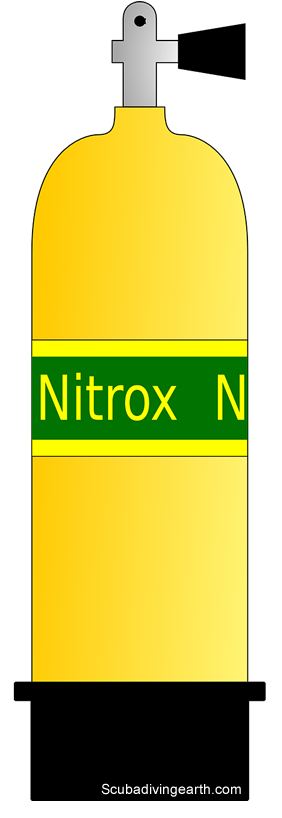
Nitrox is used to extend dive times and reduce the risk of decompression sickness by increasing the oxygen content and reducing the nitrogen content.
However, one of the ‘Cons‘ or using Enriched Air Nitrox (EAN) is that breathing EAN can lead to Hyperoxia (see below). This is due to the high partial pressure of oxygen, if used on too deep a dive for too long a time.
Nitrox bottom time calculator table
| Depth Metres (MSW) | Depth Feet (FSW) | Minutes of bottom time on 21% Oxygen BSAC Dive Tables | Minutes of bottom time on 21% Oxygen PADI Dive Tables | Minutes of bottom time on 21% Oxygen NAUI Dive Table | Nitrox 28% Oxygen (Max No Stop Time) | Nitrox 30% Oxygen (Max No Stop Time) | Nitrox 32% Oxygen (Max No Stop Time) | Nitrox 34% Oxygen (Max No Stop Time) | Nitrox 36% Oxygen (Max No Stop Time) | Nitrox 38% Oxygen (Max No Stop Time) | Nitrox 40% Oxygen (Max No Stop Time) |
|---|---|---|---|---|---|---|---|---|---|---|---|
| 12 | 40 | 122 | 140 | 130 | 232 | 232 | 371 | 371 | 371 | 354 | 354 |
| 15 | 50 | 74 | 80 | 80 | 125 | 125 | 163 | 163 | 232 | 232 | 260 |
| 18 | 60 | 51 | 55 | 55 | 74 | 92 | 92 | 125 | 125 | 163 | 163 |
| 21 | 70 | 37 | 40 | 45 | 48 | 60 | 60 | 74 | 92 | 92 | 125 |
| 24 | 80 | 30 | 30 | 35 | 48 | 48 | 48 | 48 | 60 | 60 | 74 |
| 27 | 90 | 24 | 25 | 25 | 39 | 39 | 39 | 48 | 48 | Exceeds 1:40 Po2 LIMIT | Exceeds 1:40 Po2 LIMIT |
| 30 | 100 | 20 | 20 | 22 | 30 | 30 | 30 | 39 | Exceeds 1:40 Po2 LIMIT | Exceeds 1:40 Po2 LIMIT | Exceeds 1:40 Po2 LIMIT |
| 33 | 110 | 17 | 16 | 15 | 25 | 25 | 30 | Exceeds 1:40 Po2 LIMIT | Exceeds 1:40 Po2 LIMIT | Exceeds 1:40 Po2 LIMIT | Exceeds 1:40 Po2 LIMIT |
| 40 | 130 | 12 | 10 | 8 | 15 | Exceeds 1:40 Po2 LIMIT | Exceeds 1:40 Po2 LIMIT | Exceeds 1:40 Po2 LIMIT | Exceeds 1:40 Po2 LIMIT | Exceeds 1:40 Po2 LIMIT | Exceeds 1:40 Po2 LIMIT |
Exceeds 1:40 Po2 LIMIT: The partial pressure limit of oxygen is exceeded at that depth (see "How does oxygen toxicity occur" below).
Notes:
The depths and times in this table have been based on BSAC/PADI air dive tables and the National Oceanic and Atmospheric Administration NOAA nitrox tables. This has been done for comparison purposes only and this should not be used to plan or carry out your dive. Please use the tables associated with your diver training or use a dive computer for your dive times. Nitrox 32% and Nitrox 36% oxygen mixes are the most common nitrox mixes used by nitrox divers.
Nitrox diving really benefits scuba divers is on dives of 20 metres (66 feet) and above. Dives shallower than 20 metres the air mixes of nitrox become expensive and are arguably wasteful.
For example, the dive time associated with a 15 metres (50 feet) dive it’s likely that your air will run out way before you reach the 215 minutes of no decompression stop time using 36% oxygen mix.
Myths around Enriched Air Nitrox
There are a number of myths about the use of enriched air nitrox. One such myth is that Nitrox is for deep diving, but it’s not.
Myth #1 about Nitrox – Nitrox is for deep diving
The first myth about nitrox is some think that it’s only for deep diving, when it’s not. Nitrox can reduce decompression stress on a diver at any given depth, but is most beneficial on dive depths between 20 to 30 metres (66 to 100 feet).
This is how the Divers Alert Network put it:
Today, nitrox mixes are readily available and prepared across a range of concentrations. It has a lot to offer divers, but it isn’t magic; rather, it’s a useful tool that provides benefits if used correctly. When diving according to air tables or using the air setting on a dive computer, nitrox can reduce decompression stress on a diver. When used with an equivalent air depth, this safety margin is lost, but bottom time can be extended.
Divers Alrert Network – Nitrox
The myth therefore that nitrox lets you dive deeper is a dangerous misconception. You must therefore be sure to get the necessary training and gain the appropriate certification before you use nitrox on a dive.
Myth #2 about Nitrox – Nitrox reduces your air consumption
Whilst nitrox will extend your bottom time and your no decompression stop time, it’s not true that it will reduce your air consumption or somehow make your air last longer.
Your air consumption when scuba diving depends on several factors. These include:
- The depth you dive.
- If you remain calm when diving and don’t panic.
- How good you are at controlling your buoyancy and your buoyancy control device.
- How fit and healthy you are before you dive.
None of the above factors have anything to do with the percentage of oxygen contained your air mix. Your air consumption will therefore be the same regardless of whether you increase the percentage of oxygen or not.
Myth #3 about Nitrox – Diving on nitrox is safer than diving on air
People who claim that diving on nitrox is safer than diving on air is more myth than truth (but there may be an advantage on Nitrox diving with age as noted above).
Whilst you could argue there’s some truth to this because Nitrox diving means less of a build-up of nitrogen in the body. But diving safety is more about your approach to diving than of using Nitrox.
Diving on nitrox enriched air requires you to follow the same strict safety rules and procedures as you would if you’re diving on atmospheric air. If you’re diving on Nitrox things can still go wrong. If you don’t follow safe diving practices, you are just as likely to get into trouble.
Myth #4 about Nitrox – You’re less tired when you dive on nitrox
Diving on nitrox and being less tired may be a “half-truth”. The reason behind this is thought to be based on the physiological effect of the build-up of nitrogen in our bodies as we dive more. This may be particularly true when diving repetitively on a liveaboard.
It’s argued there’s a certain amount of weariness you feel when nitrogen accumulates in your body tissues. However, when you’re diving on Enriched Air Nitrox, you breathe in less nitrogen. Therefore your body tissues absorb less of it.
It’s possible therefore, diving using EAN may reduces the tiredness of multiple dives. But this is quite difficult to prove one way or another.
How does oxygen toxicity occur?
As you dive deeper the partial pressures increase. This is explained using Boyle’s Law alongside Dalton’s Law.
Dalton’s law states that the total pressure of a gas is equal to the sum of the pressures of its component gases. Whilst the components that make up the gas you breath underwater don’t change, the pressure does as you descend.
Within the recreational scuba community and as recommended by the National Oceanic and Atmospheric Administration (NOAA), generally a maximum oxygen partial pressure of 1.40 atmospheric absolute (ATA) is recommended.
The ATA on atmospheric air or the maximum operating depth (MOD), where the oxygen content is 21%, is exceeded at approximately 60 metres (198 feet).
However, when the composition of your breathing gas is changed, the MOD needs to be adjusted accordingly.
Using the same 1.40 ATA (1:40 PO2) limit:
- 32% Nitrox mix has an MOD of 112 feet.
- 36% Nitrox mix has an MOD of 95 feet.
What happens when the ATA limit is exceed?
The result of breathing increased partial pressures of oxygen, where the ATA is exceeded, is referred to as Hyperoxia or ‘Oxygen Toxicity’.
Hyperoxia occurs when the cells, tissues and organs in your body are exposed to an excess supply of oxygen. Or where oxygen at a level which is higher than normal partial pressure of oxygen.
The body is affected in different ways by Hyperoxia. This depends on the type and length of exposure. Central nervous system toxicity is caused by short exposures to high partial pressures of oxygen.
What are the symptoms of Hyperoxia?
Symptoms of oxygen toxicity as a result of Hyperoxia can include:
- Disorientation.
- Respiratory problems.
- Myopia, which is an eye disorder causing near-sightedness.
- Prolonged exposure to higher than normal partial pressures of oxygen can result in oxidative damage to your cell membranes.
The symptoms produced from breathing high concentrations of oxygen for extended periods have for good or for bad been studied on animals. In the majority of cases these studies reported the occurrence of irritation, congestion and edema of the lungs.
In certain circumstances this even led to death following prolonged exposures to enriched oxygen.
The moral of the story is to be careful about your depths when diving using Enriched Air Nitrox.
How much does nitrox certification cost?
The cost of Nitrox certification is estimated to cost between $100-150 for the course. Getting nitrox certified can be done using the PADI’s Enriched Air Diver Course or booking yourself on BSAC’s Sports Diver Nitrox workshop.
Both Nitrox training courses teach the following:
- The various percentages of air mixes.
- How the different levels of oxygen and nitrogen affect you.
- How Nitrox diving increases bottom time, which comes from the equivalent air depth (EAD) principle.
- You will also get to practice analysing oxygen content in your scuba tank.
- Plus you’ll learn how to set your dive computer for diving with enriched air nitrox.
A final thought to nitrox diving
As an aside, I’ve been diving since 1990 and never done a nitrox course and not dived using nitrox in all that time. This has never stopped me from doing all the dives I’ve done around the world.
Often times I’m on a dive boat somewhere in the world and I’m paired-up with a dive buddy. It’s very rare that I’ve been with a diver who is either nitrox trained or on a boat that offers nitrox. But this has never compromised my dives so far!
However, this might be just me. It may be similar to when I did most of my UK diving in a semi-dry suit. This was until one of my dive buddies insisted that I try his drysuit.
Up to then I never fully appreciated the benefits of diving in cold waters using a drysuit. But afterwards, I immediately rushed out and purchase a DUI drysuit. Since then I’ve always dived in the UK using a drysuit.
It might be if I try nitrox diving I may get hooked and then actively seek out nitrox dive boats and resorts instead, so I welcome your comments below.
I hope you enjoyed this article about what are the advantages of nitrox diving
I’d love to hear from you. Tell us about your adventures of diving and snorkeling, in the comments below. Please also share your photos. Either from your underwater cameras or videos from your waterproof Gopro’s!
If this article hasn’t answered all of your questions. If you have more questions either about snorkeling or scuba diving (or specifically about what are the advantages of nitrox diving), please comment below with your questions.
There will also be many more articles about scuba diving (and snorkeling) for you to read and learn about these fabulous sports.
Have fun and be safe!




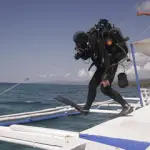

Thank you.
You are welcome Ray and happy scuba diving! ?